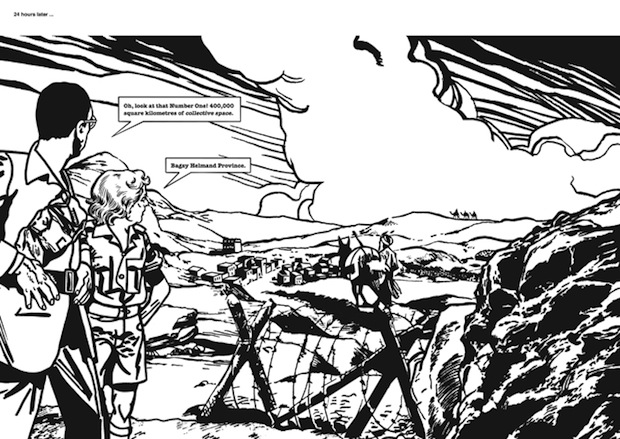
“Oh, look at that Number One! 400,000 square kilometres of collective space.”
“Bagay Helmand Province.”
Scott King: Totem Motif
Bortolami
520 W 20th Street
New York, New York
Runs through October 4, 2014
What’s on view: In the back gallery, scenes from Scott King’s graphic short story, Anish and Antony Take Afghanistan, illustrated by Will Henry, adorn the walls, alongside photographs and archival material concerning public monuments, both past and imagined.
Whitney: Scott King’s graphic short story was a solid, if simplistic, ‘fuck you’ to top-down charity models where the people with lots of money make all the decisions about how money would best be redistributed to poor people. (Telling that it was a comic.) In colonialist cigar lounges and plush government roundtables, President Obama, Angela Merkel, and David Cameron devise a plan to reinvigorate Afghanistan’s economy with public art by Anish Kapoor and Antony Gormley. One of my favorite moments is an Indiana Jones-style supply drop from parachutes suspending boxes marked “Arts Council England”. Ha, ha.
The plan backfires, though, when economic recovery goes too well. It shows the power relationships implicit in philanthropic-style public art megaprojects; what happens when cultures become powerful enough to impose their own vision for public art on the world?

Image from Scott King’s “Study of Blackpool Tower” (courtesy of betweenbridges.net) http://www.betweenbridges.net/Scott_King/02_20140619-IMG_9880%20Scott%20King_web_900px.jpg
Paddy: Was the issue really that they had their own ideas for public art, or simply that they were successful? One of the last frames just shows a graph of Afghanistan economic development going straight up and a bunch of fraught faces—including Obama’s. I got the sense that the public art programs were all a farce—a distraction ultimately meant to oppress the country. This was a strong piece.
This show requires longer looking than your average painting to get all of it. On the adjacent wall, there’s 14 black and white photographs of Blackpool Tower and the surrounding area—a mini-version of the Eiffel tower. All the pictures were taken in overcast weather, and very little effort has been made to dress these photos up. The press release tells us the tower (built in the 1890s) is now a reminder of Margaret Thatcher’s assault on the surrounding industrial Northern Britain—Thatcher was committed to reducing the power of unions and did so very effectively—which, I imagine I would put together if I were more familiar with the area? Anyway, it’s a good example of a monument that exhibits none of the qualities we typically associate with these objects. This isn’t showcasing prosperity or strength, but rather failure and poverty.


Comments on this entry are closed.